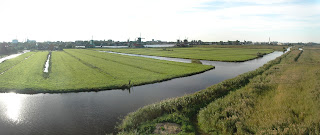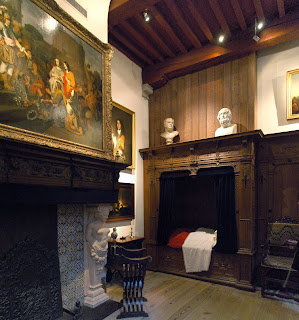28 Sep 2015. <NL> Amsterdam —
Another trip into the city to visit the Amsterdam City Museum. We visited it about seven years ago, and felt it a must-see again.
So, back across the IJ, and then down by tram to Dam Square, where we were going to have a look at the
Nieuwe Kerk (The New Church — it's only 600 years old). This church is only open to the public when it has an exhibition. Today, unfortunately, no exhibition, so we had to content ourselves with looking at it from the outside.

A barrel organ in Dam Square

The Royal Palace

Nieuwe Kerk

Dam Square is the starting point for free walking tours

A ring-in!
Then we walked down Nieuwezijds to the
Amsterdam City Museum. This
was open, and we went in. The top floor was totally different to what we saw last time — they have an exhibition called Amsterdam DNA, which is an interactive display of the history of the city. It's divided into sections ...
-
100-1500. City on Piles. This describes how the city developed around a dam built on the Amstel River — hence 'Amsterdam' — about a thousand years ago. It goes on to describe how the whole city is supported by wooden, and now concrete, piles. The Town Hall (Royal Palace) is, for example, supported bt 13,659 wooden piles. This, incidentally, explains why many Amsterdam buildings lean at disconcerting angles — as also do the buildings in Venice!
-
1550-1600. Revolt against King and Church. In 1578 Amsterdam renounced Catholicism, ousted all Catholics, and became a Calvinist city.
-
1600-1700. Centre of the World. When Amsterdam dominated world trade.
-
1795-1815. Liberty, Equality, Fraternity. When Amsterdam was conquered by the French, and Louis Bonaparte was installed into the Town Hall, now the Royal Palace. The French ban trade with Amsterdam's previous partners, and Amsterdam goes into serious decline. Then the French retreat in 1813, Amsterdam becomes capital of the new Kingdom of the Netherlands.
-
1870-1940. Towards a modern city. Amsterdam's transition from an impoverished, crowded city to a modern metropolis.
-
1940-1945. Second World War. The horrific treatment of the Jews. Anne Frank.
-
1945- Capital of Freedom. The Hippie movement, gay rights.


The women in charge of the orphanage that ultimately became this museum

The French take charge...
 Post Mill in the Schinkel neighbourhod
Post Mill in the Schinkel neighbourhod
(An early Piet Mondrian painting, c.1900)
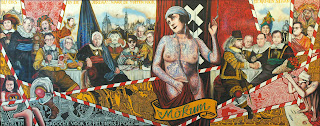
A modern version of the 16th century portraits of important citizens

- Stedenmaagd van Amsterdam
Personification of Amsterdam, with its emblem tattooed on her belly, a famous portrait of Rembrandt on her breast and the names of the two artists around her nipples.
- Anne Frank (1929-1945)
- Rik van der Ploeg (1956-)
Economist and politician (Labour Party); secretary of Culture, Art and Media Affairs from 1998 to 2002.
- Hans van Mierlo (1931-2010
Journalist and politician; founder of the D'66 Party.
- Simon Vinkenoog (1928-2009)
Writer and poet; part of the new wave in the 1950s.
- Simon Carmiggelt (1913-1987)
Writer and columnist in Het Parool newspaper.
- Rov Scholte (1958)
The artist originally selected to paint this work.
- Annie M. G. Schmidt (1911-1995)
Writer and poet.
- William Sandberg (1897-1984)
Graphic designer and typographer; director of Amsterdam's Stedelijk Museum from 1945 to 1962.
- Karel Appel (1921-2006)
Artist and sculptor; member of Cobra.
- Herman Brood (1946-2001)
Singer, artist and poet.
- Harry Mulisch (1927-2010)
Writer.
- Rudi Fuchs (1942-)
Director, including Stedelijk Museum (from 1993 to 2003).
- Joop den Uyl (1919-1987)
Politician; leader of the Labour Party and Prime Minister from 1973 to 1977.
- Johan Cruijff (1947-)
Footballer and trainer; acclaimed as the best European footballer of the 20th century.
- Alfred Heineken (1923-2002)
Head of the Heineken Brewery from 1951 to 1995.
- Job Cohen (1947-)
Lawyer and politician; mayor of Amsterdam from 2001 to 2010. Leader of the Labour Party.
- Tara Singh Vara (1948-)
Politician (1986-2001); councilor and member of parliament for the Green Party.
- Jan Cremer (1940-)
Writer and artist
- Johnny Jordaan (1924-1989)
Folk singer; famous for his songs about Amsterdam and the Jordaan neighbourhood.
- Remco Campert (1929-)
Writer; like Vinkenoog, part of the new wave of the 1950s.
- Bart Hughes (1934-2004)
Provo agitator; he drilled a hole in his own head in 1965 to expand his consciousness.
- Robert Jasper Grootveld (1932-2009)
Artist, known for his happenings in Spui; precursor of the Provo protest movement.
The downstairs area has been devoted to an exhibition of Post-Graffiti art. Many of the Graffiti artists around Amsterdam have gone on to become artists on canvas and in other media. Their works are fascinating. This in no way changes our opinion of graffiti vandals — wall art (and train art) is sheer vandalism if the owners of their 'canvases' have not given permission. And 'tagging' is just the pits — it isn't even art, it's just public defacement for the satisfaction of a small mind. But, on the other hand, we have seen in our travels many pieces of wall art that were welcomed when they were done, and which have even become monuments in their own right — take for example the Bogside Murals in Londonderry!

One of the best 'exhibits' —
the amazingly mirrored exit corridor!

We had lunch there in the museum restaurant — omelettes — yummy! Then we got on the tram to go round to Waterlooplein and
Het Rembrandthuis. On the way, we jumped out at
Rembrandtplein, as we noticed a fascinating group of statues there. On a plinth is a statue of Rembrandt, and arranged in front of it is a group of live-sized statues immediately recognizable as the members of
The Night Watch. This grouping is obviously a Mecca for tourists, as they were well represented in the square.
Back onto the tram and on to Waterlooplein. We walked up through the Flea Market to
Het Rembrandthuis, noticing as we came to it, on the canal-side, an old lock-house, standing at one of the craziest angles of any building in Amsterdam. It has now been turned into a restaurant.
The Rembrandt House is just as we remembered it, although at very top is currently being renovated/restored. Rembrandt himself was not only a painter, but an art dealer. The whole house is hung with pictures (including at least one Rembrandt), but they aren't the ones that were there in Rembrandt's time. But it gives you a good idea of what the place was like.
You can go into the kitchen, the ante-room (where he did most of his sales), his bedroom. Upstairs are two studios, one being Rembrandt's own, and the one above it, with far more restricted ceiling space, for the four students who were training under Rembrandt (at 50 Guilders per half-year). Rembrandt's studio itself has the most magic light, and there was a gentleman in there demonstrating how he prepared his paints from the raw materials. Fascinating.
From the Rembrandt House we walked across to
Niewmarkt. This, one of Amsterdam's old squares, is the site of the
Waag (Weigh-house), originally a city gate tower in the old medieval city walls, but currently a restaurant.
We continued on towards the Oude Kerk. To get there, you pass through the Red Light District. The window
shopping there is fascinating. While Warren was taking a photo of a
building with the sign 'Quartier Putain' (French for 'Red Light
District) — not one with the interesting window displays — there was
rapid movement from the nearby windows, as the all curtains were being
drawn.
We walked on to the
Oude Kerk (the Old Church, dating back to 1306). This, the oldest building in Amsterdam, currently functions in part as an art gallery — but the old choir is regularly booked for weddings. It effectively used to be a huge covered cemetery, with every flagstone in the floor actually being a tombstone. All the burials have been removed elsewhere. But it is a magnificent old building, still functioning as a Calvinist Church, sitting right in the heart of the Red Light District.

The tombstone of Rembrandt's wife Saskia

The under-side of the organ is magnificently Baroque

A photography display within the building
From here, it was but a short walk back to
Centraal Station, and the ferry back to our van. We had by now made very good use of our
I ammsterdam cards.

Another drunken building!

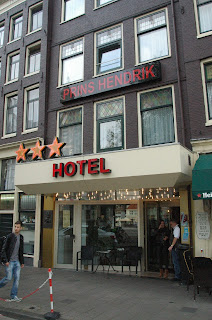
Jazz-man
Chet Baker died in a fall
from the Prins Hendrik Hotel opposite Centraal Station, in 1988

Centraal Station
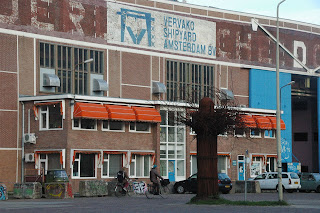
Part of the old
NDSM dock area —
this boathouse is now artists' studios and workshops
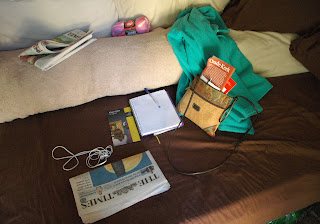
Debris dumped on the bed after a day's exploration
Distance driven — today, nil; to date, 29,021 miles ( 46,705 km )


